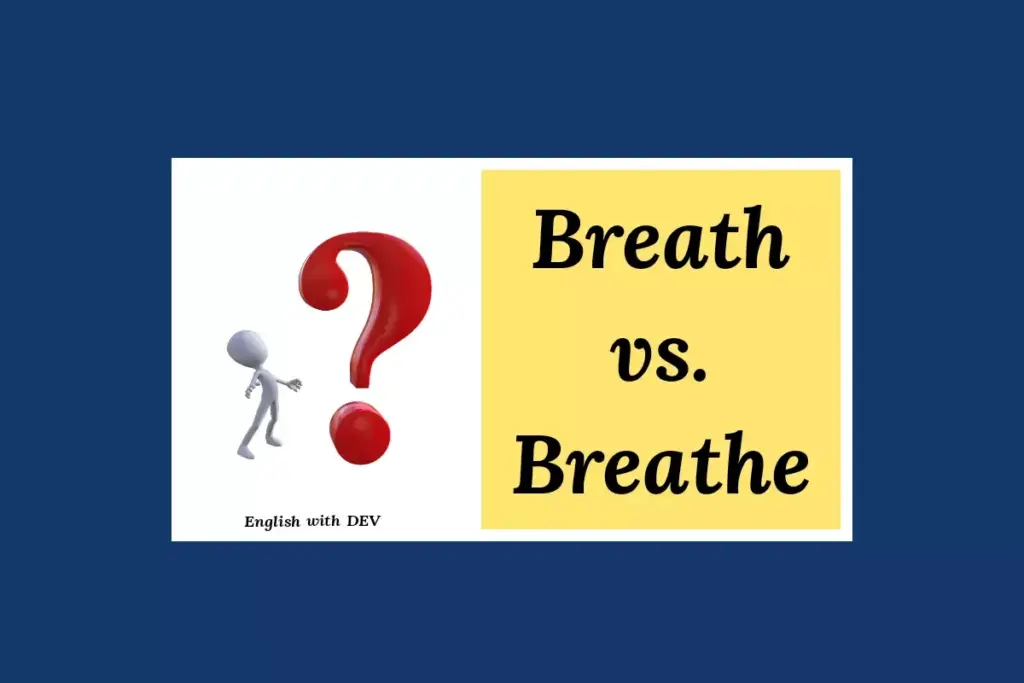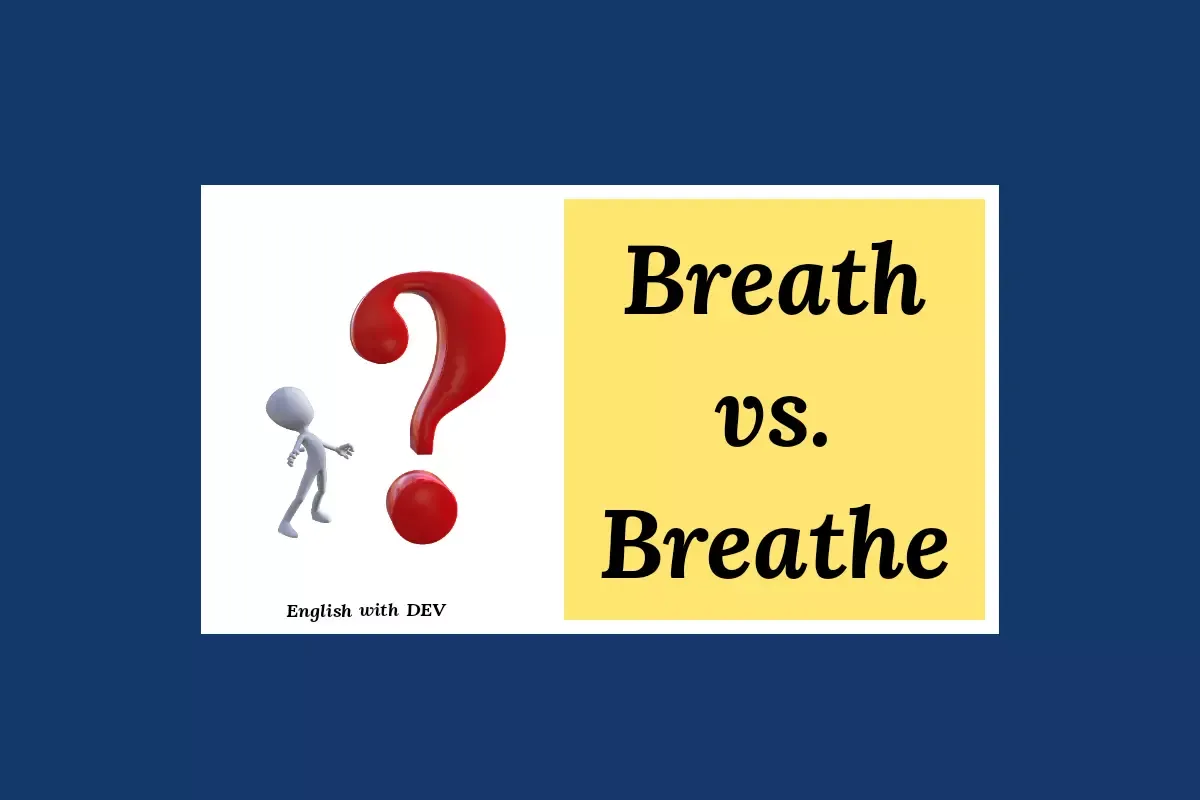
Breath vs. Breathe: Understanding the Nuances of These Common Words
The English language, with its rich history and diverse influences, often presents learners and native speakers alike with subtle yet significant distinctions between words. Two such words are “breath” and “breathe.” While they are closely related – one is the noun, and the other is the verb – using them correctly is crucial for clear and effective communication. This article will delve into the differences between “breath” and “breathe,” providing examples and practical tips to help you master their usage. Understanding the difference between the noun ‘breath‘ and the verb ‘breathe‘ is essential for conveying your intended meaning accurately.
Defining Breath and Breathe
Let’s start with the definitions. “Breath” (pronounced /brɛθ/) is a noun. It refers to the air that you inhale and exhale. It’s the physical substance that sustains life, the act of inhaling and exhaling. Think of it as the *thing* you take in and let out. For example: “She took a deep breath before the performance.”
“Breathe” (pronounced /briːð/) is a verb. It describes the act of inhaling and exhaling. It’s the *action* of taking air into and out of your lungs. For example: “Remember to breathe deeply during yoga.”
Key Differences: Noun vs. Verb
The most fundamental difference lies in their grammatical function. “Breath” is a noun; it names something. “Breathe” is a verb; it describes an action. This distinction dictates how they are used in sentences.
Consider these examples:
- Noun (Breath): “His breath smelled of coffee.”
- Verb (Breathe): “He tried to breathe slowly to calm himself.”
Pronunciation Matters
While the spelling difference is subtle, the pronunciation is more distinct. “Breath” has a short “e” sound (like in “bed”), and ends with a “th” sound. “Breathe” has a long “e” sound (like in “bee”), and the “th” sound is voiced (meaning your vocal cords vibrate when you say it). Paying attention to the pronunciation can help you remember which word to use. The correct pronunciation distinguishes ‘breath‘ from ‘breathe‘.
Common Mistakes and How to Avoid Them
A common mistake is using “breath” as a verb or “breathe” as a noun. For instance, saying “I need to breath” is incorrect; the correct sentence is “I need to breathe.” Similarly, saying “Take a deep breathe” is wrong; it should be “Take a deep breath.”
Here are some tips to avoid these errors:
- Memorize the definitions: Noun (breath) is the air itself; verb (breathe) is the action of inhaling and exhaling.
- Pay attention to pronunciation: The different vowel sounds and the voiced/unvoiced “th” can serve as cues.
- Practice with examples: Create your own sentences using both words to reinforce your understanding.
- Read carefully: Proofread your writing and double-check for any errors in usage.
Examples in Context
Let’s look at more examples to illustrate the correct usage of “breath” and “breathe” in various contexts:
- “The cold air took her breath away.” (Noun: breath)
- “She had to breathe through the pain.” (Verb: breathe)
- “He held his breath underwater for as long as he could.” (Noun: breath)
- “It’s important to breathe deeply during meditation.” (Verb: breathe)
- “The doctor listened to his breath with a stethoscope.” (Noun: breath)
- “The plants need to breathe carbon dioxide.” (Verb: breathe)
Idiomatic Expressions
English is full of idiomatic expressions that use “breath” and “breathe.” Understanding these idioms can further enhance your comprehension and fluency.
- Take someone’s breath away: To astonish or amaze someone. Example: “The beauty of the sunset took my breath away.”
- Hold your breath: To temporarily stop breathing, often in anticipation or excitement. Example: “I’m holding my breath waiting for the results.”
- Don’t hold your breath: Meaning something is unlikely to happen. Example: “He said he’d call, but don’t hold your breath.”
- Breathe a sigh of relief: To exhale audibly, expressing relief. Example: “She breathed a sigh of relief when she heard the good news.”
- Breathe new life into something: To revitalize or improve something. Example: “The new management breathed new life into the company.”
The Science of Breath and Breathing
From a scientific perspective, breath is the air we inhale, primarily composed of nitrogen, oxygen, and trace gases. Breathing, the act of breathe, is the physiological process that allows us to exchange gases, taking in oxygen and expelling carbon dioxide. This exchange is crucial for cellular respiration, the process that provides energy for our bodies. Understanding the science behind breath and breathe highlights their vital role in sustaining life. The act of breathe is fundamental to human survival, and our breath is the vehicle for this process.
Breathing Techniques for Health and Well-being
Conscious breathing techniques can have profound effects on our physical and mental well-being. Practices like deep breathing, diaphragmatic breathing, and alternate nostril breathing can help reduce stress, improve focus, and enhance overall health. These techniques emphasize the importance of the act of breathe and the quality of our breath. By consciously controlling our breath, we can influence our nervous system and promote relaxation. Learning to control your breathe can lead to numerous health benefits. [See also: The Benefits of Mindfulness Meditation]
Breath and Breathe in Literature and Art
The concepts of breath and breathe are often used metaphorically in literature and art to represent life, vitality, and inspiration. A character’s breath might be described as shallow during moments of anxiety, or deep and steady during times of peace. The act of breathe can symbolize resilience and perseverance. Artists often use imagery related to breath to convey emotions and themes. The very word ‘breath‘ can evoke a sense of fragility and the preciousness of life. The way an author uses the word ‘breathe‘ can greatly impact the reader’s perception of a scene.
Conclusion
Mastering the difference between “breath” and “breathe” is a small but significant step towards improving your English language skills. Remember that “breath” is a noun referring to the air we inhale and exhale, while “breathe” is a verb describing the act of inhaling and exhaling. By understanding their definitions, paying attention to pronunciation, and practicing with examples, you can confidently use these words correctly in your writing and speech. So, take a deep breath and breathe easy knowing you’ve mastered this linguistic challenge! Correct usage of ‘breath‘ and ‘breathe‘ enhances clarity. Always remember the distinction between ‘breath‘ and ‘breathe‘ to avoid confusion.

